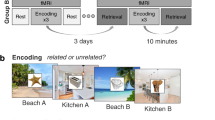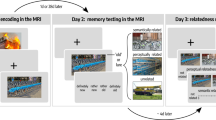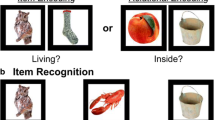Abstract
Previous studies have focused on changes in cerebral cortex activity accompanying memory formation and consolidation. Although the role of the parietal cortex in memory retrieval is well established, it is not well understood how parietal cortex memory consolidation for mathematical rules is related to granularity of stored information (i.e., degree of detail or precision). Changes in parietal cortex activity associated with memory consolidation were analyzed using the Ebbinghaus paradigm and functional magnetic resonance imaging (fMRI). Over the course of 1 week, participants learned Boolean arithmetic tasks involving stimulus-response mapping rules containing either low- or high-granularity information. FMRI images were collected on day 1 (i.e., low-granularity condition) and day 7 (i.e., high-granularity condition). The present data suggested that with practice, stored information was converted from a low-granularity to a high-granularity form. By following rule learning, it was hypothesized that the process of consolidation would involve an increased degree of rule representation granularity. Evidence for this process was reflected in parietal cortex activity. This finding was consistent with the hypothesis that mnemonic reconstruction in the parietal cortex is required for memory consolidation, and results suggested that information granules are formed during memory consolidation. The present results could increase the understanding of the relationship between memory consolidation and information granularity.
Similar content being viewed by others
References
Pedrycz W. Knowledge-Based Clustering: From Data to Information Granules. Hoboken: Wiley and Sons, NJ, 2005
McGaugh J L. Memory-a century of consolidation. Science, 2000, 287: 248–251
Dudukovic N M, Knowlton B J. Remember-Know judgments and retrieval of contextual details. Acta Psychol, 2006, 122: 160–173
Delazer M, Domahs F, Bartha L, et al. Learning complex arithmetic — an fMRI study. Cogn Brain Res, 2003, 18: 76–88
Frankland P W, Bontempi B. The organization of recent and remote memories. Nat Rev Neurosci, 2005, 6: 119–130
Olesen P J, Westerberg H, Klingberg T. How does practice makes perfect? Nat Neurosci, 2004, 7: 75–79
Dehaene S, Piazza M, Pinel P, et al. Three parietal circuits for number processing. Cogn Neuropsychol, 2003, 20: 487–506
Ischebeck A, Zamarian L, Siedentopf C, et al. How specifically do we learn? Imaging the learning of multiplication and subtraction. Neuroimage, 2006, 30: 1365–1375
Sohn M H, Albert M A, Jung K, et al. Anticipation of conflict monitoring in the anterior cingulate cortex and the prefrontal cortex. Proc Natl Acad Sci USA, 2007, 104: 10330–10334
Corbetta M, Shulman G L, Miezin F M, et al. Superior parietal cortex activation during spatial attention shifts and visual feature conjunction. Science, 1995, 270: 802–805
Piazza M, Pinel P, Le Bihan D, et al. A magnitude code common to numerosities and number symbols in human intraparietal cortex. Neuron, 2007, 5: 293–305
Verguts T, Fias W. Representation of number in animals and humans: A neural model. J Cogn Neurosci, 2004, 16: 1493–1504
Dehaene S, Spelke E, Pinel P, et al. Sources of mathematical thinking: Behavioral and brain-imaging evidence. Science, 1999, 284: 970–974
Anderson J R, Fincham J M, Qin Y L, et al. A central circuit of the mind. Trends Cogn Sci, 2008, 12: 136–143
Wagner A D, Shannon B J, Kahn I, et al. Parietal lobe contributions to episodic memory retrieval. Trends Cogn Sci, 2005, 9: 445–453
De Smedt B, Reynvoet B, Swillen A, et al. Basic number processing and difficulties in single-digit arithmetic: Evidence from velo-cardiofacial syndrome. Cortex, 2009, 45: 177–188
Cabeza R. Role of parietal regions in episodic memory retrieval: The dual attentional processes hypothesis. Neuropsychologia, 2008, 46: 1813–1827
Wagner A D, Shannon B J, Kahn I, et al. Parietal lobe contributions to episodic memory retrieval. Trends Cogn Sci, 2005, 9: 445–453
Miyashita T, Kubik S, Lewandowski G, et al. Networks of neurons, networks of genes: An integrated view of memory consolidation. Neurobiol Learn Mem, 2008, 89: 269–284
Ebbinghaus H. Memory: A contribution to experimental psychology. New York: Dover Publications, 1885/1964
Friston K J, Holmes A P, Poline J B, et al. Analysis of fMRI timeseries revisited. Neuroimage, 1995, 2: 45–53
Forman S D, Cohen J D, Fitzgerald M, et al. Improved assessment of significant activation in functional magnetic resonance imaging (fMRI): Use of a cluster-size threshold. Magn Reson Med, 1995, 33: 636–647
Talairach J, Tournoux P. Co-planar Stereotactic Atlas of the Human brain. Stuttgart: Thieme, 1988
Brett M, Anton J L, Valabregue R, et al. Region of interest analysis using the MarsBar toolbox for SPM 99, NeuroImage, 2002, 16: 497
Uncapher M R Wagner A D. Posterior parietal cortex and episodic encoding: Insights from fMRI subsequent memory effects and dualattention theory. Neurobiol Learn Mem, 2009, 91: 139–154
Vilberg K L, Rugg M D. Memory retrieval and the parietal cortex: A review of evidence from a dual-process perspective. Neuropsychologia, 2008, 46: 1787–1799
Vincent J L, Snyder A Z, Fox M D, et al. Coherent spontaneous activity identifies a hippocampal-parietal memory network. J Neurosychol, 2006, 96: 3517–3531
Author information
Authors and Affiliations
Corresponding authors
About this article
Cite this article
Wang, X., Zhong, N., Lu, S. et al. Parietal cortex contributions to information granules following memory consolidation. Chin. Sci. Bull. 55, 2671–2676 (2010). https://doi.org/10.1007/s11434-010-4063-x
Received:
Accepted:
Published:
Issue Date:
DOI: https://doi.org/10.1007/s11434-010-4063-x




